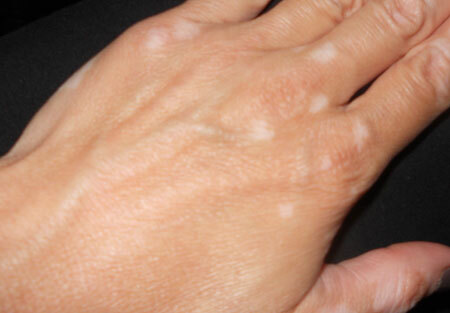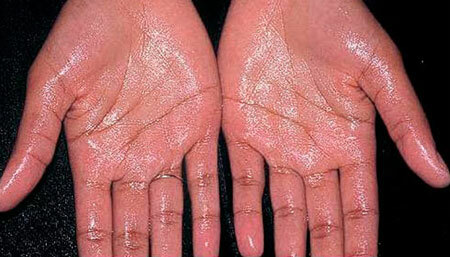Among the acute inflammatory skin diseases, allergic dermatitis is among the leading pathologies. According to the classification, it is one of the varieties of contact dermatitis.
In the WHO registry, allergic dermatitis by code ICD-10 is registered as class L23.0-L23.9( with ten qualifying diagnoses, according to provocative factors).
Develops against the background of increased sensitivity of the organism to a certain allergen, or to a group of similar in structure and chemical composition of substances. Various pathological processes on the skin manifest themselves as a response of the body to an optional( conditioned) stimulus.
Content
- 1 causes and mechanism of development
- 2 symptoms of atopic dermatitis in adults, photo
- 3 Atopic dermatitis in children
- 3.1 Complications of allergic dermatitis
- 4 diagnostic methods
- 5 treatment of atopic dermatitis in adults and children
- 5.1 Medication
- 6 Preventive measures
- 7 Allergic Dermatitis ICD-10
Causes and mechanism of development of
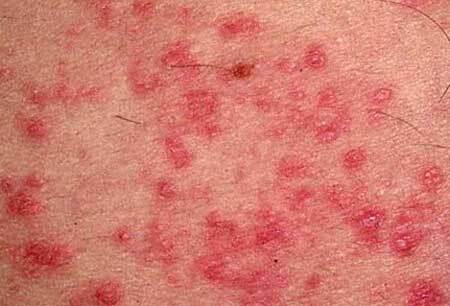
The onset of skin lesion occurs by a delayed type of formation of nontological reactions at sufficiently prolonged contact with human specific stimulus.
The development of the allergy occurs with repeated contact with an external antigen, especially in people who are predisposed to allergies and have an inherited mutant gene( autosomal recessive inheritance).
Initial acquaintance of the body with a certain substance begins with increased sensitivity to it, and only after a while, direct contact of the antigen with the skin causes the development of inflammatory processes on the skin, as a consequence of a specific reaction.
Substances( haptens) that cause this reaction have a very low molecular weight, which ensures their easy penetration into the skin.
Inside the body, they bind to the family of globulins( plasma proteins), increase in size and turn into full-blown IgE antibodies, responsible for the development of an allergic reaction.
On how quickly the allergen will contact the globulins, the manifestation of specific reactions depends. This type of disease, with the defeat of the skin develops not earlier than 1-2 weeks after the first contacts with heptens( see photo).
For example, with a professional allergy, the effect of the allergen on the skin can last for years.
Provocative factors in the development of skin allergic dermatitis can be, both internal and external stimuli:
- medications, especially antibacterial ointments;
- berries and citrus fruits;
- household chemical products;
- cosmetic and perfume components;
- varnish-and-paint materials and polymers on artificial and natural basis;
- various chemical compounds and metals.
According to the morphological code of diseases, the disease has up to a dozen varieties.
The most common manifestations are:
1) The reaction of allergic contact dermatitis, due to contact with an external irritant - domestic, food, insect bite.
2) Various forms of toxemia, which provokes a specific reaction of the body in response to the introduction of antigens into the structure of the respiratory tract, into the GI system through subcutaneous and intravenous injections of medicinal preparations, reception of provoking food, due to various external stimuli.
is characterized by a rapid manifestation in the form of extensive rashes of a large area of the skin.
3) Diathesis( atopic form) - manifests allergic dermatitis in children, adults and women in the position. It is a consequence of a combination of respiratory processes and acute inflammatory dermatosis.
Appears with a rash and skin irritation. The development of the disease stops immediately, if the provoking factor is eliminated.
4) Epidermal toxic necrolysis, characterized by a localized form of lesions in the form of local inflammation and toxic damage to the whole organism. It refers to the section of skin toxidermic damage due to the action of sulfonamide drugs.
May occur anywhere on the body. Affected areas of the dermis exfoliate from the underlying layers and die.
Symptoms of allergic dermatitis in adults, photos
Symptoms of allergic dermatitis in adults are manifested depending on the form of the disease.
1) With the contact form of the disease, the symptomatology is expressed:
- with bright red spots of eruptions in various parts of the skin that have contact with the allergen;
- followed by the replacement of spots with liquid-filled vials;
- is a constantly itchy process of focal lesions;
- spread of the rash to healthy tissue, with prolonged influence of the stimulus, accompanied by articular aches, headaches and increased temperature.
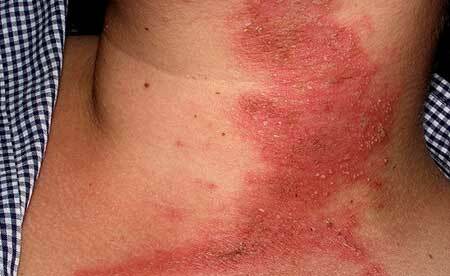
allergic dermatitis in adults, photo 1

manifestations of the disease, photo 2
2) Symptoms of toxicodermia are accompanied by:
- general weakness with possible loss of consciousness;
- with cold sweat and swelling;
- joint pain and pain in the lumbar region;
- bloody vesicles on separate areas of the skin;
- with defeat of the brain and spinal cord;
- impaired lung function and liver function.
3) Symptomatic of diathesis( atopic form) is manifested:
- strongly itching rash on various parts of the body;
- with insomnia and nervous disorders on the background of continuous itching;
- by inhibition or strong excitement;
- by the addition of staphylococcal, or streptococcal infection in the outbreaks;
- formation of purulent foci, edema, cracks and dry yellowish crusts in place of bursted combed vesicles.

crust formation at the site of scratching, photo 3
Against the background of diathesis, development of bronchial asthma, hives, conjunctivitis or cheilitis is possible. The disease proceeds in chronic form with seasonal exacerbations( in winter) and remissions( in the summer).
Exacerbation of the disease in adults causes adrenal insufficiency causing:
- a decrease in gastric secretion;
- autonomic disorders and decreased blood pressure;
- decrease in blood glucose;
- feeling of constant fatigue.
4) Signs of epidermal toxic necrolysis appear in a very short period of time after contact with an antigenic agent. Within one, three days the patient may die.
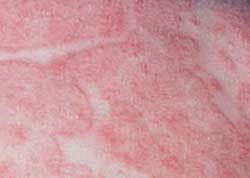 Symptoms are manifested:
Symptoms are manifested:
- sudden rise in temperature to very high rates, for no apparent reason;
- skin rashes on the trunk, arms and legs;
- with multiple edematous red spots, gradually merging into large foci;
- formation on the foci of blisters of various sizes( sizes from the palm of the diseased) covering their skin becomes thin, flabby, easily tearing under mechanical action;
- involvement in the process of lesions of the mucous membranes of the internal and genital organs.
Allergic dermatitis in children
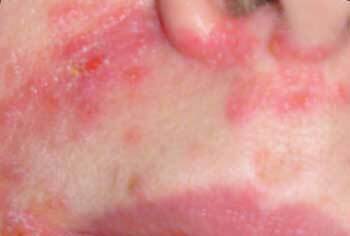
manifestations in children, photo 1
Allergic dermatitis in children develops due to the failure of immune mechanisms that are not able to withstand a different antigenic type, creating prerequisites for the development of various dermatological diseases.
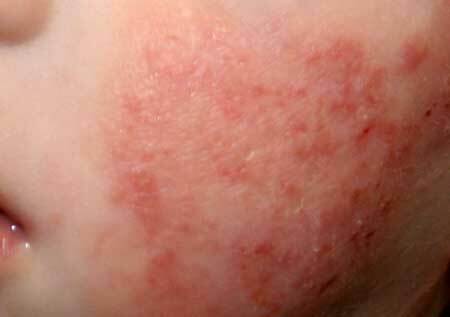
photo 2
A common cause of development of pathological reactions in a child is caused by:
- by ingestion of breast milk or artificial mixtures;
- the first lure or graft;
- contact with the surrounding reality( objects, dust, moisture, cold, etc.);
- with medicinal products;
Provoking the disease can rub the kid's skin with diapers of inappropriate size, irritating the skin with synthetic underwear and wet diapers.
All this can cause specific reactions in the inguinal zone, on the buttocks of the child, on the external genitals, in the armpits and ulnar folds, in the form of small rashes, red foci of inflammation and the main symptoms of allergic dermatitis, itching.
Pathologies of toxic-allergic nature develop in children with a gradual increase and intensification of symptoms.
:
- is shown as a red spotted rash all over the body;
- development of vesicles and skin peeling;
- by fusion of bubble formations, their opening and formation of a wetting surface;
- itching and burning at the spots of rashes;
- ulceration in the oral cavity.
The general condition of the child worsens, dyspnea, coordination disorder, drowsiness and fever occur.
At any manifestations of similar symptoms it is necessary to consult a dermatologist and an allergist - the disease is fraught with the development of various complicated processes.
Complications of allergic dermatitis
Running, untreated allergic dermatitis can cause various complications in adults and children, manifesting:
- development of purulent skin lesions;
- irreversible skin changes caused by cutaneous atrophy;
- fungal infections;
- by the defeat of the respiratory tract in the form of development of asthmatic bronchitis;
- development of ENT diseases;
- by helminthic invasions, furunculosis;
- memory reduction.
Diagnostic methods
The detection of the disease is due to the manifestation of the clinical picture. Elucidation of predisposing factors of the preceding disease. In certain cases, an analysis is made for the determination of IgE antibodies in the blood.
Detection of an allergen provoking exacerbation of the disease is carried out by the method of tests and samples:
1) Apply on the forearm of small doses of various antibodies. If the skin of a specific allergen is replaced by a reddening or blister, then the reaction is positive.
2) Application tests - applications with special paper sticky plates can identify a dozen provocative allergens.
Applicator is attached to the back of the patient for two days. When stripping, a redness or a small blister appears on the site of a certain antigen, with a sharp reaction. The changes on the skin pass without a trace immediately after the removal of the plate.
An accurate determination of the allergen promotes the selection of an effective agent for the treatment of allergic dermatitis.
Treatment of allergic dermatitis in adults and children
 General therapy for the treatment of allergic dermatitis and their symptoms in adults and children includes several points:
General therapy for the treatment of allergic dermatitis and their symptoms in adults and children includes several points:
- revealing and excluding the provoking factor;
- selection of hypoallergenic diet;
- the appointment of sedatives, enterosorbents, vitamin therapy and probiotics;
- use of antibiotics, systemic corticosteroids and antihistamines( especially for children ).
Drug Therapy
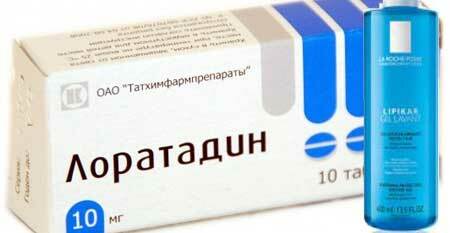
1) Special attention is paid to glucocorticosteroid preparations in the form of systemic treatment - ingestion and surface treatment of allergic dermatitis with ointment on the basis of "Deimoveyt", "Hydrocortisone" or "Elokom".
2) To prevent itching and swelling, elimination of redness, antihistamines - injections and tablets "Loratidine", "Suprastin" and "Clemastine" are of great effectiveness.
3) The use of medicinal moisturizers is due to the compaction of the skin caused by the disease. They are based on thermal waters and animal wax. The most effective are Lipikar, Atoderm, Topicrem and Trikzer
4) Treatment of allergic dermatitis with creams "Actovegin", "Solcoseryl" or "Cynovit" solves the problem of skin peeling( liberation from scales), inflammation andirritation, contributes to the rapid healing of wetting wounds and the elimination of itching.
5) Fast healing of dry wounds is promoted by paste or ointment - "Bepanten", "Advantan", "Pentanol".
Prevention measures
Children susceptible to various forms of allergic dermatitis should be on dispensary registration in the clinic under the constant supervision of a doctor.
Parents should provide proper care for the skin of the child with the use of special cosmetics, preventing her from drying out, cracking or intertrigo. Observe a strict diet, eliminating the effects of allergens.
For children and adults, with any treatment, medications should be prescribed only by a specialist doctor.
It is inadmissible to prescribe more than five medications for the treatment of any one disease. Completely eliminate attempts at self-treatment.
Allergic dermatitis ICD-10
Detailed information on finding the disease in the ICD classifier 10:
Class XII - Diseases of the skin and subcutaneous tissue
( L20-L30) Dermatitis and eczema
Code( L23) Allergic contact dermatitis
- ( L23.0) Allergiccontact dermatitis caused by metals
- ( L23.1) Allergic contact dermatitis due to adhesive substances
- ( L23.2) Allergic contact dermatitis caused by cosmetic products
- ( L23.3) Allergic contact dermatitis due to medication(L23.4) Allergic contact dermatitis due to dyes
- ( L23.5) Allergic contact dermatitis due to other chemicals
- ( L23.6) Allergic contact dermatitis due to food products when they come into contact with the skin
- ( L23.7) Allergic contact dermatitis due to plants other than food
- ( L23.8) Allergic contact dermatitis due to other substances
- ( L23.9) Allergic contact dermatitis, cause not specified


